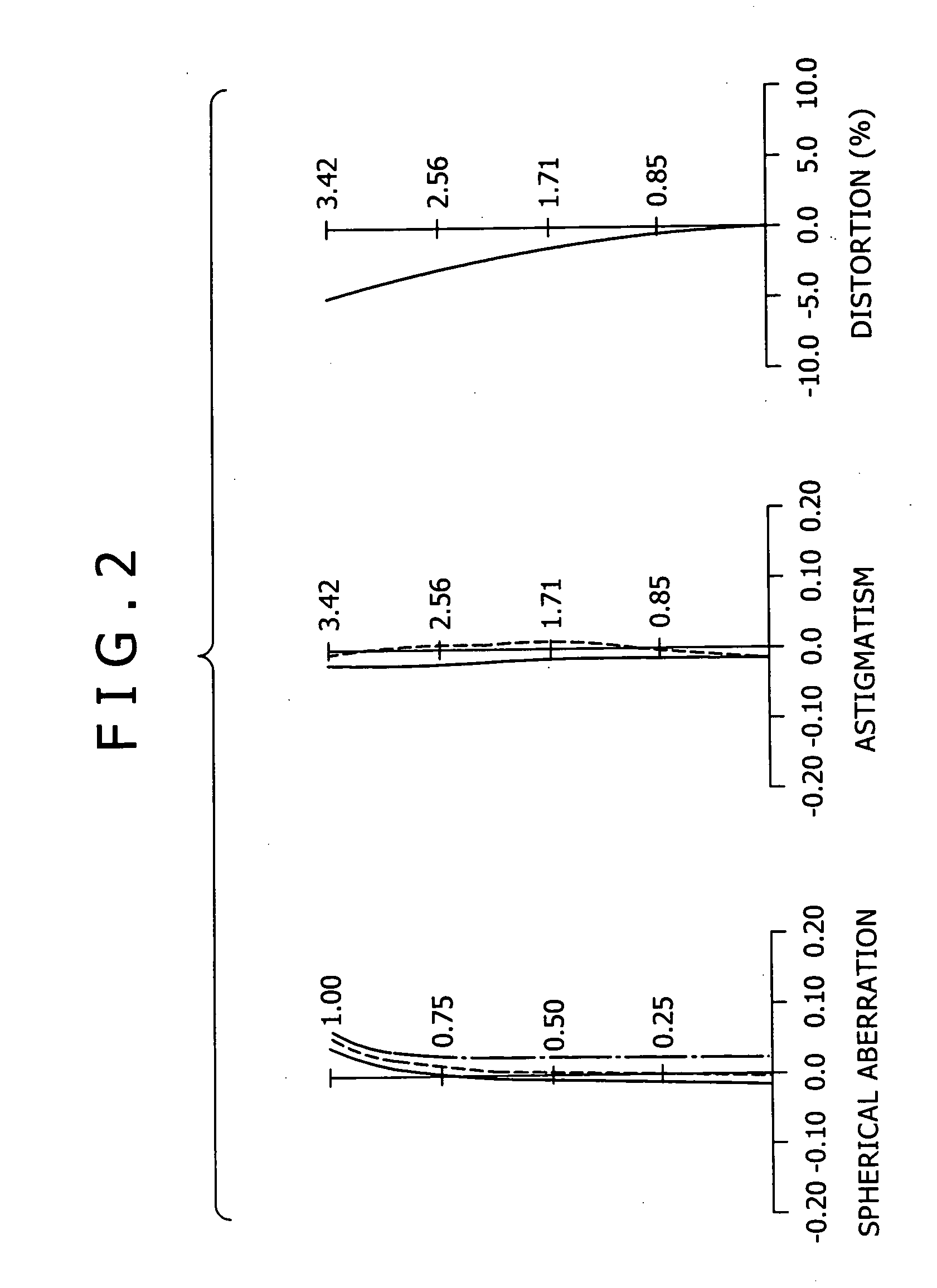Zoom lens and imaging device
a technology which is applied in the field of zoom lens and image pickup apparatus, can solve the problems of difficult to make the zoom lens lower in profile, difficult to have a higher magnifying power, and large aberration changes, so as to reduce the size of the reflective member, the effect of lowering the profil
- Summary
- Abstract
- Description
- Claims
- Application Information
AI Technical Summary
Benefits of technology
Problems solved by technology
Method used
Image
Examples
first embodiment
[0051] In the zoom lens 1 the axial distance (air gap) d6 between the first lens group GR1 and the second lens group GR2, the axial distance (air gap) d10 between the second lens group GR3 and the iris aperture IR, the axial distance (air gap) d16 between the third lens group GR3 and the fourth lens group GR4, and the axial distance (air gap) d18 between the fourth lens group GR4 and the fifth lens group GR5 change during zooming. Table 2 shows axial distances (air gaps) at the wide-angle end state, an intermediate focal point position between the wide-angle end state and the telescopic end state, and the telescopic end state, f-numbers (FNO), and half angles co of view. In Table 2, f represents the focal length of the entire lens system.
TABLE 2f6.0009.00016.800FNo3.9954.3395.046ω30.98220.23511.078d60.5003.9148.213d108.2134.7990.500d160.7001.9964.649d185.0453.7491.096
[0052] In the zoom lens 1 according to the first embodiment, the opposite surfaces s5, s6 of the second lens G3 of t...
second embodiment
[0063] In the zoom lens 2 the axial distance (air gap) d8 between the first lens group GR1 and the second lens group GR2, the axial distance (air gap) d15 between the second lens group GR2 and the third lens group GR3, the axial distance (air gap) d21 between the third lens group GR3 and the fourth lens group GR4, and the axial distance (air gap) d23 between the fourth lens group GR4 and the fifth lens group GR5 change during zooming. Table 5 shows axial distances (air gaps) at the wide-angle end state, an intermediate focal point position between the wide-angle end state and the telescopic end state, and the telescopic end state, F-numbers FNO, and half angles co of view. In Table 5, f represents the focal length of the entire lens system.
TABLE 5f6.00015.00042.000FNo3.6064.0464.128ω33.69113.5054.967d80.50011.42021.125d1521.22110.3010.596d214.05911.90616.257d2313.1985.3511.000
[0064] In the zoom lens 2 according to the second embodiment, the opposite surfaces s7, s8 of the third len...
third embodiment
[0070] In the zoom lens 3 the axial distance (air gap) d8 between the first lens group GR1 and the second lens group GR2, the axial distance (air gap) d13 between the second lens group GR2 and the iris aperture IR, the axial distance (air gap) d19 between the third lens group GR3 and the fourth lens group GR4, the axial distance (air gap) d22 between the fourth lens group GR4 and the fifth lens group GR5, and the axial distance (air gap) d24 between the fifth lens group GR5 and a protective filter LPF change during zooming. Table 8 shows axial distances (air gaps) at the wide-angle end state, an intermediate focal point position between the wide-angle end state and the telescopic end state, and the telescopic end state, F-numbers FNO, and half angles co of view. In Table 8, f represents the focal length of the entire lens system.
TABLE 8f6.89912.76033.696FNo3.6003.7173.939ω29.70816.5376.252d80.6585.50811.14048d1311.2826.4330.800d191.3903.2206.948d228.6693.8592.000d242.0004.9803.111
[...
PUM
 Login to View More
Login to View More Abstract
Description
Claims
Application Information
 Login to View More
Login to View More - R&D
- Intellectual Property
- Life Sciences
- Materials
- Tech Scout
- Unparalleled Data Quality
- Higher Quality Content
- 60% Fewer Hallucinations
Browse by: Latest US Patents, China's latest patents, Technical Efficacy Thesaurus, Application Domain, Technology Topic, Popular Technical Reports.
© 2025 PatSnap. All rights reserved.Legal|Privacy policy|Modern Slavery Act Transparency Statement|Sitemap|About US| Contact US: help@patsnap.com



